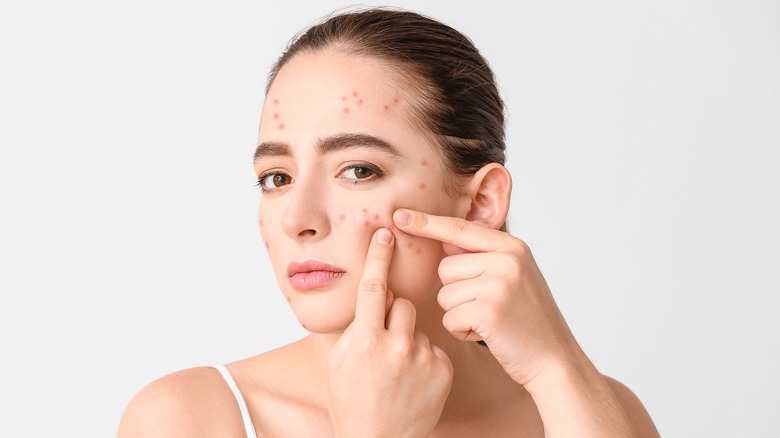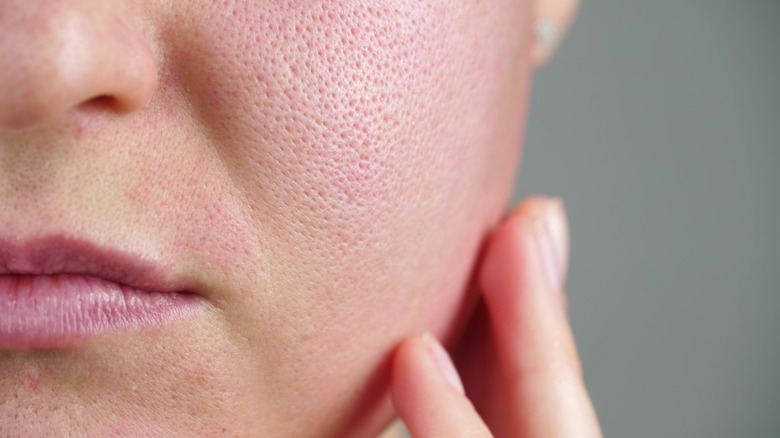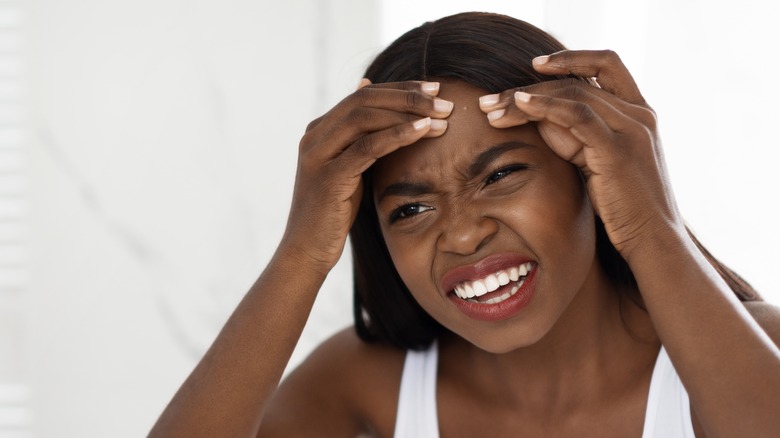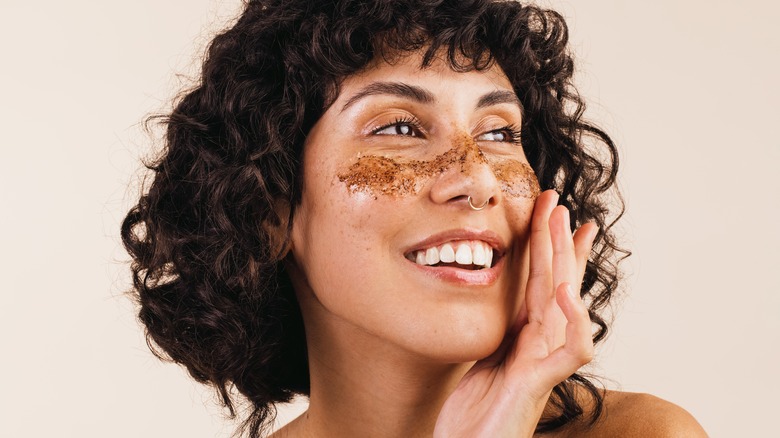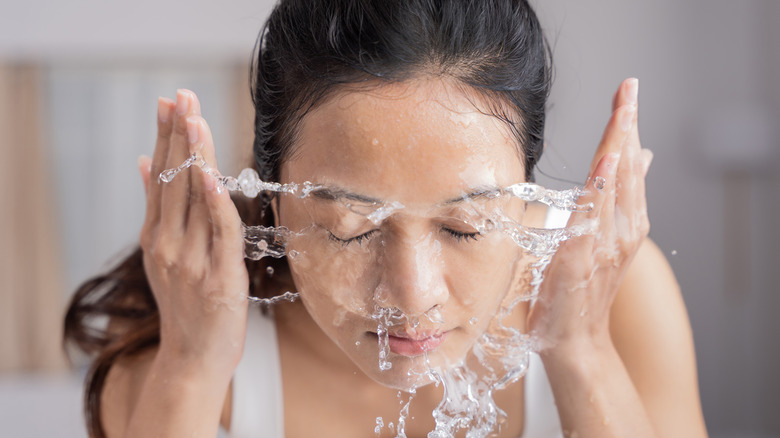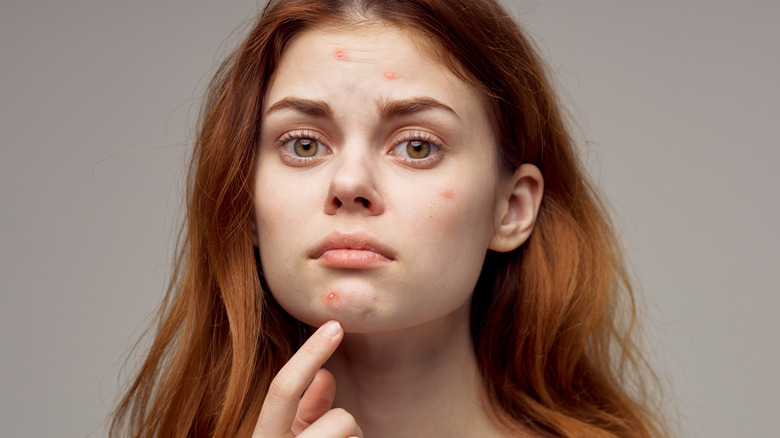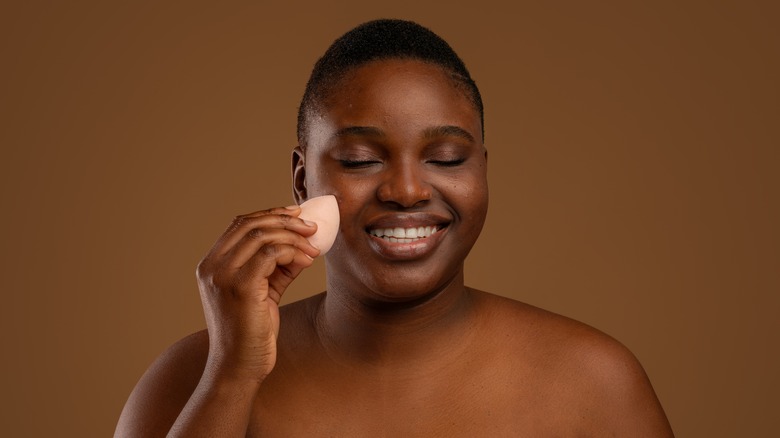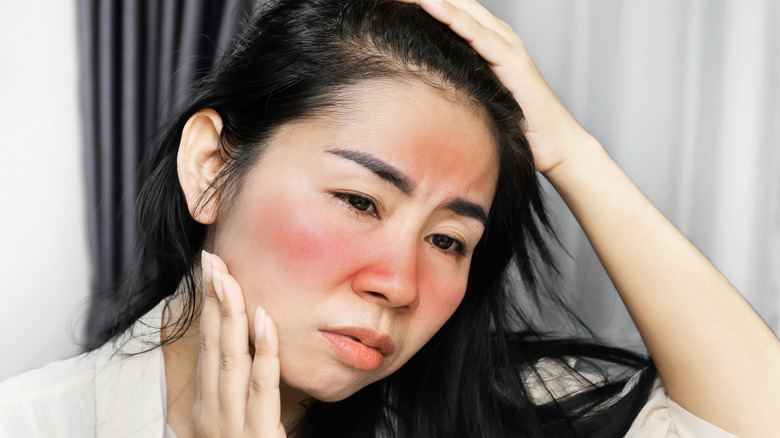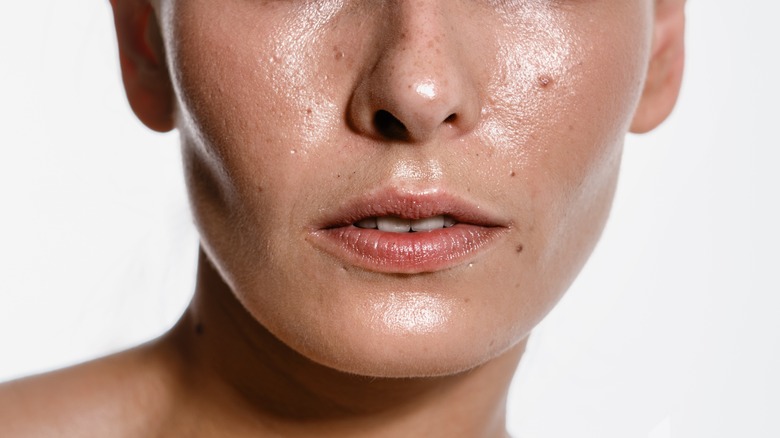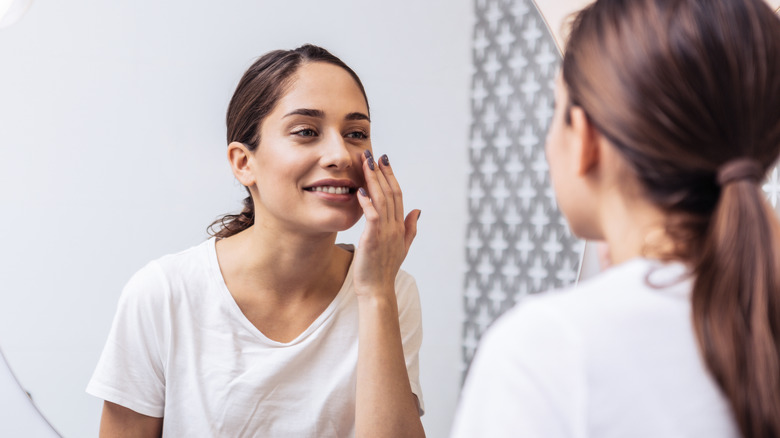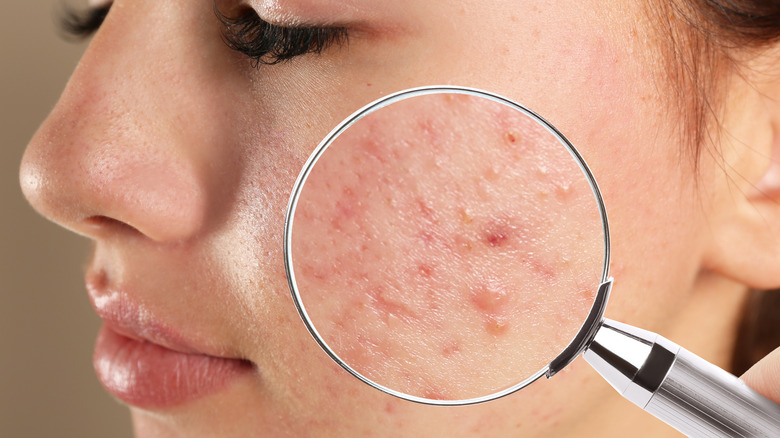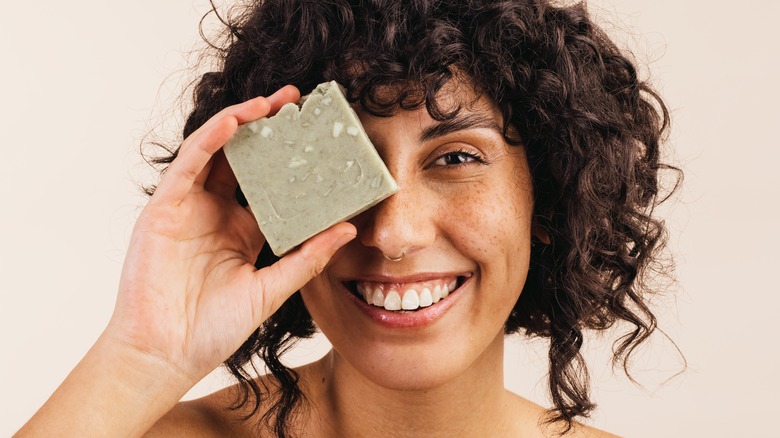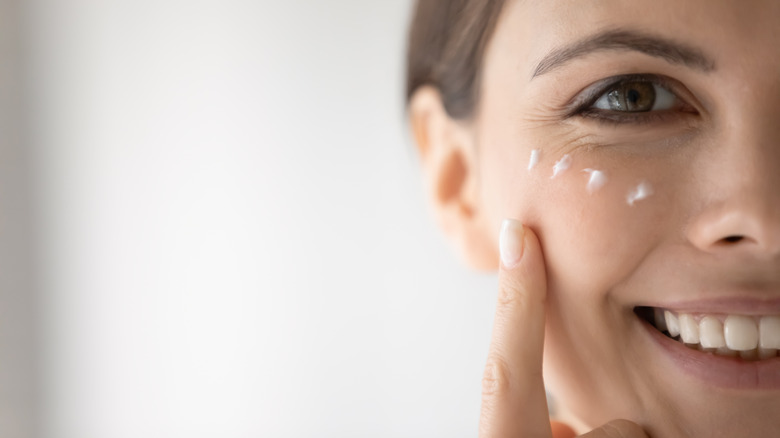15 Acne Myths You Should Stop Buying Into
We may receive a commission on purchases made from links.
Acne is a persistent skin condition that comes in a range of forms, including whiteheads, blackheads, cystic lesions, and pimples (via Mayo Clinic). Typically beginning during puberty, it varies in its severity and may last for years for some. And although acne is not a dangerous health condition, it can have devastating effects on the mental well-being of individuals who suffer from it, according to Dermatology Learning Network, as it can lead to feelings of poor self-esteem and insecurity that can linger well into adulthood.
As a result, it is no wonder that so many myths about acne exist. People are desperate to rid themselves of unsightly bumps, shrink their pores, and achieve smooth, perfect skin. As such, there are boatloads of old wives' tales and misguided information out there claiming to be the gold standard of skincare. Although some myths have a basis in reality, many of the supposed "cures" can actually make acne worse. This guide discusses 15 myths about acne you should stop believing, as well as some actual tips to help you improve your complexion.
Myth: Pores open and close
Pores are "tiny openings around hair follicles and sweat glands that help gases and liquids move through the surface of your skin," according to the skincare experts at Kiehl's. While they exist wherever oil glands are on the skin, they are primarily concentrated on the face, particularly on and around the nose.
It is widely believed that this functionality means the pores on your face open and close like little doors. However, because pores do not have muscles, they cannot contract, according to How Stuff Works. This also means that pores cannot be opened with steam or closed with fancy face masks or a splash of cold water, as many acne myths suggest. Pore size is also largely determined by genetics (via The Dermatology Specialists).
Although they cannot grow or shrink at will, pores will dilate when clogged with dead skin and excess sebum leading to blackheads or pimples. Washing your face with hot water or steam can help loosen the congestion and make it easier to remove over time. While this will help cleanse your skin and help prevent future breakouts, it will not permanently alter the size or shape of your pores.
Myth: Popping pimples is perfectly safe
As tempting as it is to squeeze a pimple, it isn't wise to do so at home. No matter how safe you think you're being, popping a zit can lead to nearby pores becoming infected and increased inflammation, or worsen the existing breakout (via American Academy of Dermatology). Attempting an at-home extraction can also irreparably damage the underlying skin tissue, causing discoloration or stubborn scars, Mayo Clinic reports.
It is extremely satisfying to see the gunk evacuate a painful pimple, but at the end of the day, the risks of doing so outweigh any benefits. If you need a pimple to vanish ASAP, spot treating with products with salicylic acid can help, as can at-home remedies like ice cubes. "Applying ice directly to the blemish will help to decrease inflammation, reducing the size and visibility of the spot," celebrity facialist Candace Marino told Glamour. Exercising patience, avoiding picking or touching, and implementing a regular skincare routine is the safest way to effectively reduce pimples over time.
Myth: Harsh exfoliation is the key to a deep clean
Skin exfoliation has been a prime aspect of skincare routines since ancient Egyptian times (via Healthy Beginnings). It is the process of removing dead skin cells from the outer layer of skin, either with a brush, loofah, or a chemical product. According to How Stuff Works, the idea is that sloughing off the dead skin cells will make skin appear brighter and smoother, and potentially increase collagen production. It is also believed to help prevent clogged pores. But is harsh exfoliation the key to a deeper clean and less acne? The answer is no.
Although our skin exfoliates naturally in a 28 to 45-day cycle, manual exfoliation can speed up the process. However, dermatologists often caution against at-home exfoliation altogether due to the damage that can be done if performed incorrectly. Over-exfoliating can strip the skin causing swelling, redness, skin peeling, and uncomfortable tightness (via SkinKraft). Over time, the regular inflammation can lead to a breakout. To avoid this, implement the "less is more" policy and exfoliate no more than twice a week.
Myth: Junk food causes breakouts
The effects of junk food on the skin are a confusing mix of fact and fiction. It is a myth that eating a chocolate bar or enjoying a slice of pizza will cause a breakout overnight. A host of factors other than diet contribute to acne, including hormone levels, allergies, irritants, and dry skin (via Hers).
However, according to the Center for Surgical Dermatology and Dermatology Associates, because acne is an inflammatory condition, it can be triggered by a diet heavy in simple sugars and carbohydrates. High-glycemic foods also spike insulin levels in the body, leading to full-body inflammation, according to AnnmarieGianni.com. Additionally, some studies suggest that milk and dairy products can play a role in causing breakouts as well (via New York Times), although no conclusive evidence currently exists.
Eating a balanced diet is important for your overall health. Focusing on eating nutritious foods may help reduce the likelihood of a breakout, but the occasional chocolate bar, wine Wednesday, or fried dinner is unlikely to cause a severe breakout.
Myth: Washing your face more often will prevent acne
Contrary to popular belief, washing your face more often will not prevent acne. Similar to over-exfoliation, washing your face too often can harm your skin by stripping away its protective barrier (via Hers). Without this barrier, the skin is exposed to dirt and irritants, making it more likely for breakouts to occur. Overwashing can also strip away the skin's natural oils causing dry skin and kickstarting an overproduction of oil, which can clog pores.
According to Skincare.com, how often you wash your face ultimately depends on your skin type and cleansing needs. However, a 2006 study published in Pediatric Dermatology saw acne conditions worsen when participants washed their faces only once a day. Those that washed their faces twice a day saw improved comedones and non-inflammatory lesions. These findings coincide with dermatologists' general recommendations to wash your face once in the morning and once at night.
Myth: Only teenagers suffer from breakouts
Breakouts usually begin when teenagers go through puberty. During this time, hormones called androgens start to increase the size of oil glands which leads to an overproduction of sebum (via American Academy of Dermatology). Although acne is extremely common in teenagers and young adults because of this, they are not the only age group to suffer from breakouts.
Adult acne is referred to as hormonal acne (via Cleveland Clinic). Hormonal acne affects people ages 20 to 50 and is tied to the natural fluctuation of hormones in the body. It can appear as cysts, blackheads, whiteheads, or regular pimples. It can also show up anywhere on the body, including the back and shoulders. This type of acne is caused by excess sebum, bacteria, and dead skin cells in the oil glands which clog the pores. Hormonal acne is more common in women than men and can coincide with menstrual cycles and menopause.
Myth: Makeup causes breakouts
While it is true that some makeup may aggravate your skin, not all makeup contains ingredients that will inevitably lead to acne. Breakouts caused by makeup are called acne cosmetics, according to the American Academy of Dermatology. These types of breakouts present as dozens of tiny bumps along the hairline, chin, cheeks, and lips. They can take weeks to show up and are difficult to get rid of if the offending makeup is continually worn.
Despite this, it is a common misconception that wearing makeup of any kind will result in a breakout. The key to preventing makeup-triggered acne is to carefully research makeup brands and their formulas. Look for terms like "non-comedogenic" or "oil-free" on the packaging, as this type of makeup was made specifically to not clog pores (via Proactiv). It is also important not to sleep in your makeup. Cleansing your face every time you wear makeup can help eliminate the potential for a makeup-related breakout down the line.
Myth: Sun exposure clears up pimples
The idea that sun exposure or tanning can clear up existing pimples is a widely-believed myth. In reality, all tanning does is temporarily make blemishes less noticeable by darkening the skin, according to Stryx. Getting a tan can also initially reduce the amount of oil on your fave because UV rays dry out the skin (via Clearlyderm). But after your sunbathing session, your skin will compensate by overproducing oil, potentially causing a breakout or making the acne you already have worse.
In addition, too much sun exposure is dangerous for your overall long-term health. Excessive, unprotected exposure to UV light can lead to skin cancer, including melanoma (via Skin Cancer Foundation). It also causes premature aging in the form of wrinkles, loose skin, and dark sunspots. These conditions can be improved with the help of a dermatologist, but they cannot be reversed entirely. Wearing fragrance-free sunscreen with ingredients like zinc-oxide will protect against the sun's harmful rays and limit the chances for a breakout.
Myth: Oily skin causes acne
Oily skin can be a pain to treat, but it doesn't necessarily cause acne. People with dry and combination skin can be acne-prone just as people with oily skin can have a clear complexion (via Aedit). What matters more is how the oil interacts with the dead skin cells and bacteria on the skin's surface.
While too much oil in the skin can clog the pores and lead to a breakout, it is not the sole cause. People with oily skin have overactive sebaceous glands, often as a result of being dehydrated, according to Dermalogica. This is normally the result of a variety of factors, including genetics, weather conditions, and even certain medications (via Biore).
Avoiding touching your face during the day and sticking to a cleansing routine can help reduce the amount of oil the skin produces (via Aspire Dermatology). Balancing the amount of hydration your skin receives in the form of drinking water, moisturizer, and using appropriate skin care products will also make a huge difference.
Myth: Toothpaste will dry out pimples
Before the days of OTC acne spot treatments, women feared a pimple popping up the day before a school dance or wedding. It was widely believed that placing a dab of toothpaste on a surprise blemish would dry it out quickly, thanks to the concentration of baking soda, hydrogen peroxide, and other chemicals present (via How Stuff Works). While technically these drying ingredients could cause a pimple to go away at some point, there is no guarantee it will happen fast or without causing additional damage to the skin.
The menthol and minty flavors in many kinds of toothpaste can cause allergic reactions in some people (via Australian Skin Clinics). This can result in dry, red, or peeling skin. Using toothpaste as an acne treatment can also lead to itchy rashes that can spread. If you have sensitive skin, using toothpaste as an emergency acne spot treatment is not recommended.
Myth: Pimples appear overnight
We've all experienced going to bed with a clear complexion and waking up with a huge, red zit throbbing on our faces. We immediately blame the greasy food we ate before bed or the new makeup tried on the day before, confident that something must have happened to make the pimple appear overnight. After all, it wasn't there the day before, right?
The truth is, pimples don't just appear. A pimple forms when sebum in the oil gland mixes with dead skin cells, dirt, and bacteria (via NewYork-Presbyterian). The mixture plugs the pore, becomes inflamed, and can lead to an infection. According to Acne Nation, this process can take anywhere from one to two weeks. Blackheads can take a little longer, appearing anywhere from two to four weeks after being extracted (via Acne.org). This means that your sudden breakout can be the result of sunburns, fluctuating hormones, or an oil-based makeup product from weeks before.
Myth: Bar soap will worsen acne
Although it has earned a bad reputation in the skincare community, bar soap is unlikely to worsen your acne. Some bar soaps contain inferior ingredients that can strip the skin of moisture and cause dry skin (via Skincare.com). Many bar soaps also contain artificial dyes and fragrances that interact poorly with sensitive skin, according to Avail Dermatology.
However, there are many bar soaps specially formulated to fight breakouts and introduce a much-needed burst of moisture to the skin. According to Well and Good, bar soap with active ingredients such as salicylic acid or benzoyl peroxide is excellent for combating body acne, particularly on the back and shoulders. If you are interested in using a facial bar to combat acne, look for one with a pH of 5.5. Soap-free facial bars made with glycerin are also good to try as they won't strip the skin of its natural oils (via Medical News Today).
Myth: Stress directly causes breakouts
Many women associate stress with breakouts but the science linking the two is murky. According to Healthline, stress does not cause acne. On the other hand, several studies have concluded that stressful life events, such as an undesirable illness, can increase the appearance of acne while undergoing stress management can seemingly improve it (via Medical News Today).
The truth about stress as a cause of acne lies somewhere in the middle. Being stressed out is unlikely to spark a nasty breakout, although stressful experiences can potentially worsen an existing breakout. This is likely because of the hormonal response your body undergoes when stress courses through your body. Stress hormones, known as cortisol, are secreted by your body's endocrine system which contributes to greater production of sebum, according to the American Academy of Dermatology, as reported by ScienceDaily.
Ultimately, a variety of factors contribute to the presence of acne, including sleep habits, diet, exercise, and hygiene habits, among others. If you notice an increase in pimples after a stressful period, the breakout may be related to stress. If breakouts occur during periods of low or sporadic stress, a combination of other factors is the more likely culprit.
Myth: Working out worsens acne
If you've ever worried your workouts are the cause of your breakouts, you are in good company. Many women fear that getting their sweat on will lead to unmanageable bouts of acne, but that simply isn't true. The natural and necessary act of sweating helps regulate your body's temperature and prevent it from overheating, according to Florida Dermatology. However, it also helps flush out acne-causing dirt, bacteria, and oil trapped in the pores.
The real culprit of workout-related acne is poor hygiene and wearing improper workout gear. Allowing the sweat to dry on your skin instead of washing it off creates a barrier that locks in acne-causing gunk. To avoid this, shower as soon as possible after a workout. Tight-fitting clothes are also related to acne as they can irritate the hair follicles and glands during your workout. Stick with loose, breathable workout gear and remove it immediately after to avoid prolonged contact with your skin (via UW Health).
Myth: Acne will go away on its own
Over 50 million people in the United States alone suffer from acne (via Today). Despite how common it is, and the fact that it is a natural process of the body, acne is a persistent skin condition that is unlikely to go away on its own. Individual pimples will heal on their own over time, but without some form of treatment and a good skin care regimen, acne will continue and can potentially worsen.
Thankfully there are numerous treatment options for acne regardless of how it presents itself or the age you are when you get it (via American Family Physician). Mild acne is normally treated with over-the-counter or prescription topical ointments containing benzoyl peroxide or retinoids. Oral medicines can help with more severe cases, as can antibiotics like clindamycin. Some women find oral contraceptives can help reduce their acne symptoms as well (via American Academy of Dermatology). In addition to these medical treatments, eating a balanced diet, getting enough sleep, and practicing good hygiene are all ways to help acne disappear.
